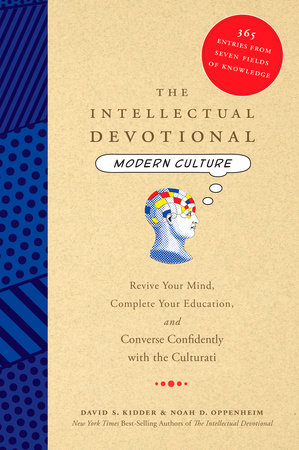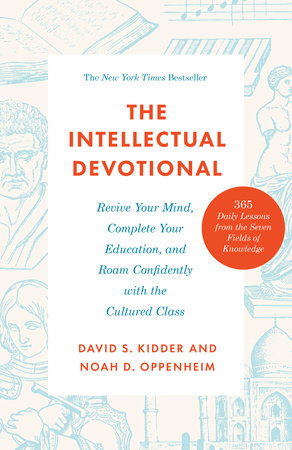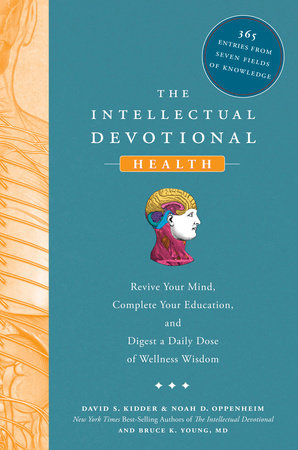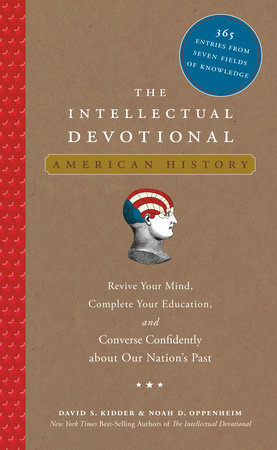Excerpt
The Intellectual Devotional: Modern Culture
WEEK 1
Sigmund Freud
Sigmund Freud (1856-1939) was a leading intellectual and psychologist who shaped the study of the human mind in the twentieth century. Through his controversial concept of psychoanalysis, use of hypnosis, and analysis of dreams, he sought to bring light to people's inner lives and motivations, and in doing so, he had a dramatic impact on not only psychology but also philosophy, sociology, and art.
Freud's work has seemingly prompted just as many people to call him a charlatan as call him a genius. After graduating from the University of Vienna with a medical degree in neurology, he went to Paris to study under Jean-Martin Charcot (1825-1893), who specialized in the study of hysteria. What Freud saw in treating patients led him to conclude that mental disorders stemmed from psychological or emotional trauma, not physical problems or natural development.
While in Paris, Freud began using hypnosis on his patients during psychoanalysis, which led to the development of his central theory: that man is endowed with an unconscious, made up of repressed memories, that has strong emotional and sexual drives. These drives, some of which are born in infancy, battle one another for control and ultimately guide human behavior.
In 1899 he published The Interpretation of Dreams, his most widely known work. He theorized that dreams were full of complex symbolism and were an effort by the subconscious to provide clues to human desires.
In The Ego and the Id (1923), Freud introduced his theory of the three competing areas of the mind: the id, which is home to the most primitive drives; the ego, which is the conscious self that interacts with reality; and the superego, which recognizes and observes the restrictions imposed by societal norms.
His focus on and belief in the power of the unconscious mind led Freud to think that all jokes, slips of the tongue, and dreams had meaning or showed insight into the human mind.
ADDITIONAL FACTS
1. Freud experimented with cocaine and studied its euphoric effects on himself and others.
2. Before devoting himself to psychology, Freud conducted zoological research and is credited with discovering testicles in eels--a small detail that had escaped earlier studies.
3. Freud came from an Austrian Jewish family, and four of his sisters died in Nazi concentration camps during World War II.
4. Freud's impact on pop culture is clearly visible in works ranging from the television show The Sopranos to the films of Woody Allen (1935-) to the surrealist art of Salvador Dali (1904-1989).
Crime and Punishment
In many respects, Fyodor Dostoyevsky's Crime and Punishment was the first true twentieth-century novel--even though it was published in 1866. This story of murder, guilt, alienation, and redemption set the stage for many modernist and existentialist works of the century that followed, and it continues to make its mark on both literature and film today.
Set in St. Petersburg, Russia, the novel focuses on Raskolnikov, a young student who believes himself capable of greatness but feels frustrated by poverty and lack of opportunity. He decides that, because of his extraordinary potential, it would be justifiable for him to kill a miserly old pawnbroker and use her amassed fortune to achieve great things. When he acts on his plan, though, he panics, botches the robbery, and inadvertently kills a second woman without managing to steal the money. Tormented by this failure, Raskolnikov sinks into malaise and questions his real motives for the crime--and all the while is hounded by an investigator who may or may not have any proof of his guilt.
Crime and Punishment is renowned as one of the first--and still one of the greatest--examples of the psychological novel, in light of its intricate explorations of Raskolnikov's motivations and mental state. At the same time, it is a remarkable work of suspense: Tension builds as we wonder whether Raskolnikov will get caught or whether he might even confess of his own accord. In fact, much like a crime potboiler, Crime and Punishment was published serially over the course of a year. The novel brought Dostoyevsky (1821-1881) a desperately needed financial windfall that enabled him to catch up on his gambling debts, and his contemporaries, including the novelist Leo Tolstoy (1828-1910), immediately hailed it as a landmark. In the years since, Sigmund Freud (1856-1939), Friedrich Nietzsche (1844- 1900), Jean-Paul Sartre (1905-1980), and Albert Camus (1913-1960), among others, have cited it as a direct influence.
ADDITIONAL FACTS
1. Crime and Punishment inspired two of Woody Aliens (1935-) most highly regarded films, Crimes and Misdemeanors (1989) and Match Point (2005).
2. In his late twenties, Dostoyevsky was sentenced to death by firing squad for participating in meetings of a clandestine left-wing political group. Czar Nicholas I (1796-1855) commuted the sentence at the last minute, and the author was sent to a Siberian labor camp for four years instead--an experience that indisputably inspired parts of Crime and Punishment.
3. Dostoyevsky struggled for years with a compulsive gambling habit. Luckily, he was able to mine this compulsion for its literary value, producing the novel The Gambler in 1866.
Pyotr Ilyich Tchaikovsky
Russian composer Pyotr Ilyich Tchaikovsky (1840-1893) wrote several of the most popular ballets in music history, including Swan Lake (1877), The Sleeping Beauty (1890), and his Christmas classic, The Nutcracker (1892). In addition to his dance works, Tchaikovsky composed dozens of orchestral works, including seven symphonies.
Tchaikovsky was born in the small Russian town of Votkinsk and began studying piano at the age of five. At first, his parents did not encourage his musical pursuits, believing that a "passionate" hobby would be dangerous for an already frail and sickly child. Eventually, however, Tchaikovsky moved to the Russian capital of St. Petersburg, where he completed his musical education. Czar Alexander III (1845-1894) was an admirer of his work. Another patron, Nadezhda von Meck (1831-1894), granted him a yearly stipend that allowed him to continue his musical endeavors.
In addition to his ballets, Tchaikovsky is best known today for his bombastic 1812 Overture (1880), which commemorated the Russian victory over the French emperor Napoleon Bonaparte (1769-1821) and includes cannon fire and church bells as part of the instrumentation. Tchaikovsky also wrote eleven operas. The most famous are Eugene Onegin (1879) and The Queen of Spades (1890), both based on dramatic poems by the nineteenth-century Russian poet Aleksandr Pushkin (1799-1837).
Tchaikovsky became popular around the world during his career and toured the United States in 1891, introducing Americans to his now-classic compositions. Two of his works--the 1812 Overture and The Nutcracker--have become sentimental favorites in American culture and are often performed on the Fourth of July and at Christmastime, respectively.
ADDITIONAL FACTS
1. Tchaikovsky's last work was his Symphony no. 6, entitled Pathetique (1893). The composer died nine days after premiering the work, which was played as a requiem at his memorial.
2. Though there was once speculation that Tchaikovsky committed suicide after being exposed in a homosexual affair, most scholars today believe that he died of cholera.
3. Though Tchaikovsky's opera Eugene Onegin is considered a masterpiece, the Russian author Vladimir Nabokov (1899-1977) dismissed it as "silly" and "slapdash," saying that everything in it "insults Pushkin's masterpiece."
The Lumiere Brothers
The French duo of Louis and Auguste Lumiere did not invent cinema, but they are considered the founding fathers of modern film for creating the primitive motion-picture projector they patented in 1895. The brothers were inspired by the work of American inventor Thomas Edison (1847-1931), who in 1893 had unveiled a machine called the Kinetoscope, which allowed viewers to watch short films by peering into a wooden box that held the device's components.
The Lumieres, whose family business manufactured photographic equipment and supplies, improved on the Kinetoscope with the Cinematographe, a lightweight, hand-cranked apparatus that was both a camera and a projector. And unlike the Kinetoscope, which allowed only one viewer to watch the moving pictures, the Cinematographe could project movies onto a screen, allowing members of an audience to watch a movie together.
The Lumieres patented the Cinematographe in February 1895, and many historians consider December 28, 1895, to be the birthday of cinema. On that day, the Lumiere brothers projected films for the first time for a paying audience at the Grand Cafe on the Boulevard des Capucines in Paris. The program included ten films--among them Workers Leaving the Lumiere Factory (1895)--and lasted about twenty minutes.
In 1896, the brothers took the Cinematographe and their films on a world tour, including stops in London and New York City. According to legend, some spectators were so spooked by Arrival of a Train at La Ciotat (1895)-- which was a single shot of a train as it approached a station from the background--that they ran away in terror.
By 1900, the brothers had created 2,000 films. But believing that "cinema is an invention without any future," the brothers did not sell their camera to other filmmakers and went on to focus their efforts on still photography.
ADDITIONAL FACTS
1. Louis Lumiere (1864-1948) was a trained physicist.
2. Auguste Lumiere (1862-1954) ran the family business, which manufactured photographic equipment and supplies.
3. The Lumieres hired a pianist to provide live musical accompaniment to their short movies at the first screening in Paris.
Communism
"A specter is haunting Europe--the specter of communism." With those words, Karl Marx (1818-1883) and Friedrich Engels (1820-1895) opened their 1848 Communist Manifesto, a political broadside that launched one of the most powerful political movements of the nineteenth and twentieth centuries.
At the time that Marx and Engels published their pamphlet, communism was a fringe movement associated with a few failed revolts and some obscure and difficult works of German philosophy. A century later, however, it dominated half the globe.
The communists believed that the Industrial Revolution of the early nineteenth century had created deep economic inequalities, as factory owners and investors reaped enormous profits while workers toiled in poverty. Capitalism, the communists believed, created great wealth, but the middle class--the bourgeoisie--wanted to maintain their position of power in society instead of sharing it with workers--the proletariat.
The solution, Marx and Engels proposed, was for the working class to take control of the means of production themselves, establishing what they termed a "dictatorship of the proletariat." Since the bourgeoisie would never surrender their power voluntarily, Marx and Engels believed, violent revolution was necessary.
The communists were hostile not only to capitalism but also to imperialism and religion--which Marx described as "the opium of the people." Indeed, in the eyes of its opponents, communism posed a direct threat to the Western way of life.
Amid the poverty and social strife of nineteenth-century Europe, however, communism found many adherents and spread steadily in the years after Marx and Engels's manifesto. With the Russian Revolution of 1917, communists gained the ability to put their ideas into practice.
The growing clash between capitalism and communism defined the world politics of much of the twentieth century, particularly the four decades of the Cold War. Although a few nations, such as China, remain nominally communist, the ideology lost much of its allure after the horrors of life in the "worker's paradise" of the Soviet Union were exposed to the world.
ADDITIONAL FACTS
1. Marx is best known for books such as The Communist Manifesto and the three-volume Capital, but he also worked for many years as a journalist, publishing in British and American newspapers, including the New York Daily Tribune.
2. Though communism achieved its first great victory in Russia, Marx and Engels regarded that country as backward and underdeveloped and hoped the communist future would be ushered in by the United States.
3. Marx was annoyed when communist philosophy was later labeled Marxism; he once reportedly proclaimed, "I am not a Marxist."
James Naismith
Of the three great American sports--baseball, basketball, and football-- only one has a true inventor. On December 21, 1891, James Naismith, a Canadian-born physical education teacher, nailed peach baskets to two opposite walls of a gymnasium in Springfield, Massachusetts, handed his students a soccer ball, and announced thirteen rules for his new game--and "basket ball" was born.
Naismith (1861-1939), the son of Scottish immigrants, grew up in Ontario and was orphaned by age nine. (His parents died of typhoid fever.) After dropping out of high school at fifteen to work as a lumberjack, he eventually returned to school, earning degrees from McGill University and Presbyterian College, where he studied to become a minister.
In 1890, he enrolled at the Young Men's Christian Association (YMCA) International Training School in Springfield. While there, he and his fellow students were given the task of devising an indoor activity for the men at the YMCA to play during the winter, between football and baseball seasons.
At the time, calisthenics and gymnastics were essentially the only indoor athletic activities, but they were deemed too boring by many of the men. The only stipulations for the new game were to "make it fair for all players and free of rough play."
Naismith's invention proved popular, and his thirteen rules were soon published in a sports magazine to an enthusiastic response. In the following years, Naismith remained prominently involved with the game as it grew, particularly in the evolution of its rules into their current form. In 1898, he took a job at the University of Kansas, where he coached for ten years and remained as an athletic administrator and campus chaplain until shortly before his death at age seventy-eight.
ADDITIONAL FACTS
1. Naismith's original rules did not permit dribbling--players could advance the ball only by passing.
2. Naismith became an American citizen in 1925.
3. In his senior year at McGill, an incident on the rugby field changed his life--another player uttered an expletive and, upon seeing Naismith (an aspiring minister), he said, "I beg your pardon, James. I forgot you were there." At this point, Naismith realized that he might be able to help young men improve their lives through spiritual and physical development.
4. Naismith is the only coach in University of Kansas history with a losing record. He notched fifty-five wins and sixty losses between 1898 and 1907.
Coney Island
Located at the southern edge of Brooklyn, the amusement parks at Coney Island first opened in the 1890s and reigned for decades as the biggest and most popular in the United States. At its peak, Coney Island drew millions of visitors annually and was famous for carousels, Ferris wheels, roller coasters, fortunetellers, horse racing, freak shows, and, of course, hot dogs.
The first rides to open at Coney Island were rickety, often unsafe contraptions. In 1911, for instance, two women died after the roller coaster they were riding, the Giant Racer, jumped from its tracks eighty feet in the air.
Still, the parks were enormously popular and attracted an estimated 32 million visitors in 1904. Several vintage rides from the parks' golden age, including the Cyclone, a wooden roller coaster built in 1927, remain in operation.
In an era before movies and television, amusement parks were one of the first forms of mass entertainment. Most large American cities built amusement parks in the 1910s and 1920s, although none rivaled the hurly- burly of Coney Island, which comprised several sprawling, privately owned amusement resorts, including Luna Park and Steeplechase Park.








